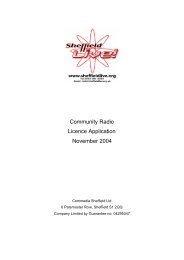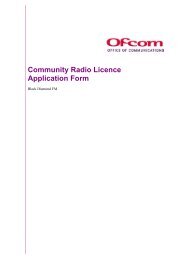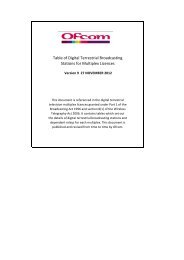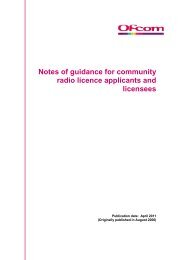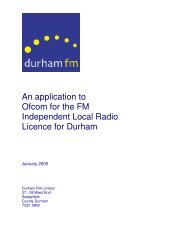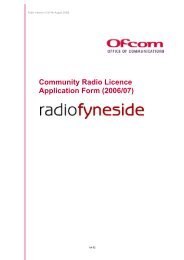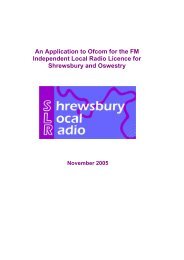UHF2 realignment study - Ofcom Licensing
UHF2 realignment study - Ofcom Licensing
UHF2 realignment study - Ofcom Licensing
Create successful ePaper yourself
Turn your PDF publications into a flip-book with our unique Google optimized e-Paper software.
7.2.2 Practical issues in assessing the costs and benefits of band alignment<br />
In practice, the process of conducting a cost-benefit analysis of various band alignment<br />
options involves estimating the monetary value of initial and ongoing expenses (costs)<br />
caused by the market intervention. These costs are then weighed against the expected<br />
return (benefits) of the market intervention to derive the net-benefits. The total net benefits<br />
are then compared against the ‘do nothing’ scenario (the base case), as well as to the net-<br />
benefits that result from other market interventions.<br />
Constructing robust measures of the costs and benefits of specific actions is often difficult.<br />
This is because the size of many of the costs and benefits can depend crucially on a number<br />
of future unknowns, or involve making judgements on the consumers ‘willingness to pay’ or<br />
the producers ‘willingness to supply’.<br />
Methods to try to estimate total benefits include using survey methods such as asking<br />
consumers how much they would be willing to pay for a certain service or by drawing<br />
inferences from market behaviour, such as revealed preference techniques.<br />
In order to simplify the calculations, many cost-benefit studies assume that the supply curve<br />
is relatively flat. With a relatively flat – or horizontal – supply curve, there are only marginal<br />
changes in the size of producer surplus (or none if the supply curve is horizontal) which<br />
allows the analysis to focus solely on estimating the size of changes in consumer surplus as<br />
it can provide a reasonable measure of the total change in social welfare.<br />
In addition, we note that band alignment may lead to the freeing up of additional spectrum<br />
that will facilitate the provision of new services. In this case, we are then interested in<br />
estimating the entire value of the consumer and producer surplus (rather than change in<br />
surplus measured for existing services). The value producers are willing to pay for spectrum<br />
is a proxy of the magnitude of the social welfare benefits that accrues as a result of band<br />
alignment.<br />
Another practical issue to consider is to ensure that all relevant costs and benefits are<br />
assessed on a comparable basis. To do this, a discount rate is used to compute all relevant<br />
future costs and benefits in present-value terms. This is because the costs and benefits may<br />
accrue both now and into the future. Our analysis will use the UK Treasury discount rate<br />
estimates.<br />
i. How accurate is cost-benefit analysis?<br />
The accuracy of cost-benefit analysis studies are only as good as the quality of the data<br />
used in the analysis. Many of the drivers of benefits and costs are based on estimates of<br />
future unknown events, such as the potential number of consumers willing to purchase the<br />
service once the intervention has been implemented. Hence, there are inherent dangers in<br />
predicting finite net benefits or costs. Usually, sensitivity analysis is deployed to check the<br />
impact of particular factors. As a result, it is normal to present a range of potential outcomes.<br />
240689 - 450-470 Study Final Print<br />
Version (Dec08).doc<br />
Page 61<br />
abc





